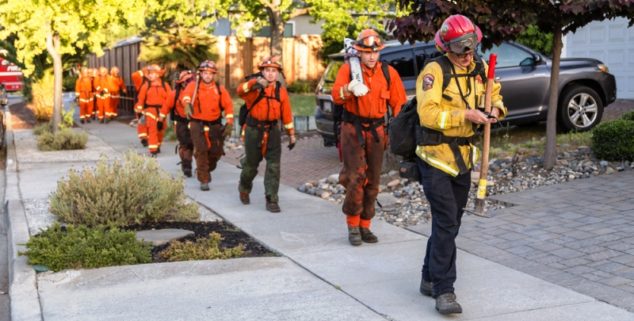News
From prison to wildfires: Inmate program gathers momentum
 Inmate firefighters head to the Colleen Fire in the Santa Teresa Foothills near San Jose. (Photo: Jaden Schaul, via Shutterstock)
Inmate firefighters head to the Colleen Fire in the Santa Teresa Foothills near San Jose. (Photo: Jaden Schaul, via Shutterstock)The law that offers wildfire-fighting inmates a chance to clean up their records in hopes of civilian careers got off to a slow start last year as administrators crafted rules for the procedure, but now, with those rules in place, the prison-to-profession pipeline is starting to take shape.
Until last year, former inmates were out of luck if they wanted to use their hard-earned skills in civilian life. Their criminal records disqualified them from becoming Emergency Medical Technicians. And fire departments all over California require EMT certification as a condition of hiring.
“They are some of the most sought-after resources we have with the big fires.” — Justin Schmoll
Rather than changing the qualifications for EMTs, lawmakers in 2020 gave inmate firefighters a chance to ask a court to clean up their records so they can meet the rigid rules for EMT certification.
While the court can still decline the request, the mere fact they can make the request gives these former inmates an opportunity unavailable to the vast majority of California’s nearly 100,000 inmates.
Inmate firefighters have earned that chance, said Justin Schmollinger, staff chief of the Camps and Crews Program for CalFIRE. Inmates do a very difficult job in brutal conditions and professional fire crews depend on them.
“They are some of the most sought-after resources we have with the big fires,” he said of the crews.
“It’s a great law. There are very few record-cleaning options for folks coming out of prison.” — Ashleigh Dennis
As the prison population declines, so too does the number of inmates available for fire work, making those who do it all the more valuable. This year, Schmollinger expected enough inmates for 152 fire crews, but the California Department of Corrections and Rehabilitation, or CDCR, sent just 57.
CalFIRE has long hired former crew members, Schmollinger said. But CalFIRE doesn’t need EMTs in the same way as urban or suburban departments, where putting out fires is only part of their mission.
Creating new EMTs is a big deal, said Schmollinger, but it’s not the only benefit.
“The most important thing with the expungement is that it opens doors to get jobs in general, not just firefighting jobs,” he said. “Not everyone is cut out to be a firefighter, not even the ones who are fire line qualified. But it opens doors to get jobs in general, and that’s really important to them.”
Ashleigh Dennis can attest to that. She’s a litigation staff attorney who has helped former inmates clean their records as part of her work for the advocacy and assistance organization Root and Rebound.
Not all of the former inmate crew members want a career with a fire department. Dennis said she helped one woman clean her record to become a nurse.
While there are plenty of success stories, it’s unclear exactly how many people have had convictions expunged.
“It’s a great law,” Dennis said. “There are very few record-cleaning options for folks coming out of prison.”
Although “expungement” sounds like a complete erasure, it isn’t. A cleaned-up “rap sheet” still includes the crime, but shows that the conviction has been dismissed, which is enough to qualify for many jobs.
While there are plenty of success stories, it’s unclear exactly how many people have had convictions expunged.
CDCR has a role in each case, since they must verify to the court that a former inmate actually served on a crew, but they don’t keep count of those verifications, said CDCR spokesperson Terri Hardy. Neither does the Judicial Council, which oversees the courts.
For their part, Root and Rebound has worked with nearly 60 people seeking expungement. Attorney Dennis handled 23 of those cases, 14 of which were successful, five denied and the others are pending rulings. Exactly how many others are helping and how often they are successful is a matter for speculation.
Whatever the number, though, it’s unlikely to put a significant dent in the state’s deepening shortage of firefighters.
The population of eligible people is limited. There are hundreds, not thousands, of inmates working fire lines.
And the program had a slow start. For the first year, attorneys were flying somewhat blind. The law became effective Jan. 1, 2021, but the Judicial Council did not approve the forms that provide lawyers and judges a standardized guide until last October, and those forms did not take effect until Jan. 1 of this year.
“It’s been taking a long time” to get people across the finish line, said Dennis. “There have been a lot of delays, but it’s a new implementation and no one is to blame. It’s an amazing help that I’m just forever grateful it exists.”
Want to see more stories like this? Sign up for The Roundup, the free daily newsletter about California politics from the editors of Capitol Weekly. Stay up to date on the news you need to know.
Sign up below, then look for a confirmation email in your inbox.

Leave a Reply